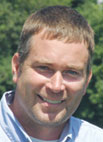 Frog Bayou Farms bridges the gap between city and farm life. Owners Sean and Stephanie Brister farm 600 acres that span from within the city limits on Main Street in Alma, Ark., to the surrounding rural countryside in Crawford County. The Bristers and their two young sons, Ross, 8 and Wyatt, 6, are passionate about farming and welcome the public to enjoy and learn about many of the crops and livestock that are integral to Arkansas’ economy each fall.
Frog Bayou Farms bridges the gap between city and farm life. Owners Sean and Stephanie Brister farm 600 acres that span from within the city limits on Main Street in Alma, Ark., to the surrounding rural countryside in Crawford County. The Bristers and their two young sons, Ross, 8 and Wyatt, 6, are passionate about farming and welcome the public to enjoy and learn about many of the crops and livestock that are integral to Arkansas’ economy each fall.
“We developed Frog Bayou to promote education. The community is not necessarily exposed to agriculture,” he related. Sean added that although the area is still relatively rural many of their visitors are surprisingly unfamiliar with where our food comes from. “I know we are getting through to them though,” he said. He estimated that 900 students with school sponsored field trips and several hundred individuals visited the farm in 2012.
Frog Bayou is open by appointment to groups during the week and to the public on Saturdays and Sundays through October. The price of admission includes the corn maze, hay ride and other family activities. The visitors will be able to play games and make their way through a hay tunnel. This year, they planted nearly a half-acre of cotton as part of their educational program. They will not harvest it but allow the bolls to open for visitors to see. A petting zoo will include locally raised animals including sheep, goats, pigs and poultry that the Brister’s borrow from other area farms.
Sean is originally from Blytheville, Ark., where his family raised cotton and soybeans but he moved to Fayetteville, Ark. to attend the University of Arkansas where he earned degrees in Agronomy and Law. He now has a general practice law firm in Alma and also specializes in agricultural law. He can provide services regarding farm equipment, government programs and estate planning.
Stephanie grew up on a stocker cattle ranch near Mulberry, Ark. In Fayetteville she earned degrees in Ag Business and Animal Science, then went on to focus on Ag Economics. She is currently Business Development Manager for Dentek in Alma as well as managing the family’s stocker operation and handling the marketing for the farm. “As part of my master’s degree I developed an economic analysis spreadsheet tool that has been helpful for cattle marketing,” she said.
She also maintains their website and a Facebook page to keep visitors and friends up-to-date on progress and upcoming events.
The couple purchased their home and 12 acres near Alma in 2005 where they ran a few head of cattle. They added 500 acres and the row crops in 2011 and another 80 in 2012. Three years ago they began triple cropping with cattle, winter wheat and soybeans and are always working to improve their program. Sean said that the high cattle prices were an enticing factor for raising multiple crops on the same plot of land. “The yield on the grain was probably somewhat reduced due to the grazing, but the gain from the cattle more than offset it. As wheat prices fall and cattle prices remain strong more wheat will be grazed out and less cut for grain,” he said.
They raise their stocker cattle to around 750 pounds grazing them on the winter wheat. He explained that crop insurance requires that cattle are removed from any wheat that will be harvested for grain by March 1, although they continue to graze out some wheat until May which enables them to plant soybeans at the optimal time.
He also stated that on much of the farm they use high tensile electric fence instead of barbed wire. “It had a cheaper initial cost and can be moved and removed easily. Also a portion of the farm is subject to flash flooding and the high tensile fence should withstand that better.”
They carry fewer cattle on permanent pasture through the summer, then they extend the grazing season in colder months by overseeding wheat and annual rye by no-till drilling their pastures which are primarily Bermuda.
Sean explained that they determine soil fertility and fertilizer application based on Extension Service guidelines. “Wheat planted after soybeans receives fertilizer based on whether it is intended for grain or grazing only,” he said. “Conventional tillage after removing the cattle seems to help soil compaction issues caused by cattle running on the wheat during wetter winter months.”
The couple plans to continue growing their farm. Sean said that he would like to be able to farm full-time some day, and they will continue their goal of public outreach. “We have a lifetime passion in agriculture and we want to share that with others,” he said.







